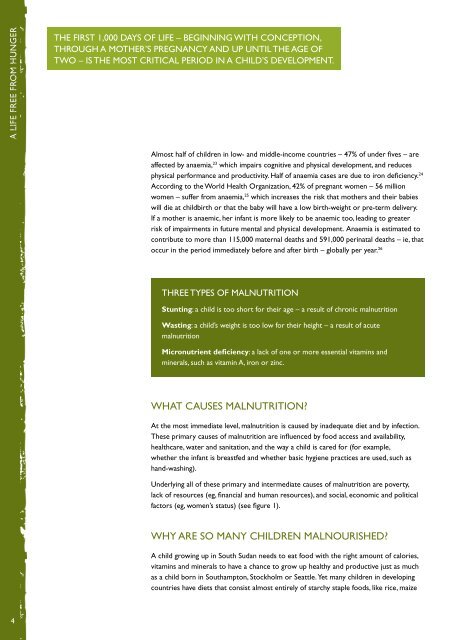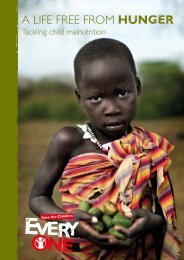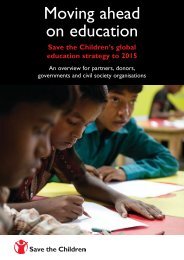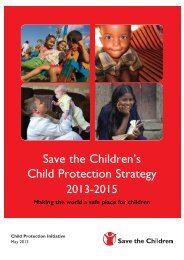NGER A LIFE FREE FROM HUNGER - Save the Children
NGER A LIFE FREE FROM HUNGER - Save the Children
NGER A LIFE FREE FROM HUNGER - Save the Children
Create successful ePaper yourself
Turn your PDF publications into a flip-book with our unique Google optimized e-Paper software.
a life free from hunger<br />
THE FIRST 1,000 DAYS OF <strong>LIFE</strong> – BEGINNING WITH CONCEPTION,<br />
THROUGH A MOTHER’S PREGNANCY AND UP UNTIL THE AGE OF<br />
TWO – IS THE MOST CRITICAL PERIOD IN A CHILD’S DEVELOPMENT.<br />
Almost half of children in low- and middle-income countries – 47% of under fives – are<br />
affected by anaemia, 23 which impairs cognitive and physical development, and reduces<br />
physical performance and productivity. Half of anaemia cases are due to iron deficiency. 24<br />
According to <strong>the</strong> World Health Organization, 42% of pregnant women – 56 million<br />
women – suffer from anaemia, 25 which increases <strong>the</strong> risk that mo<strong>the</strong>rs and <strong>the</strong>ir babies<br />
will die at childbirth or that <strong>the</strong> baby will have a low birth-weight or pre-term delivery.<br />
If a mo<strong>the</strong>r is anaemic, her infant is more likely to be anaemic too, leading to greater<br />
risk of impairments in future mental and physical development. Anaemia is estimated to<br />
contribute to more than 115,000 maternal deaths and 591,000 perinatal deaths – ie, that<br />
occur in <strong>the</strong> period immediately before and after birth – globally per year. 26<br />
THREE TYPES OF MALNUTRITION<br />
Stunting: a child is too short for <strong>the</strong>ir age – a result of chronic malnutrition<br />
Wasting: a child’s weight is too low for <strong>the</strong>ir height – a result of acute<br />
malnutrition<br />
Micronutrient deficiency: a lack of one or more essential vitamins and<br />
minerals, such as vitamin A, iron or zinc.<br />
WHAT CAUSES MALNUTRITION<br />
At <strong>the</strong> most immediate level, malnutrition is caused by inadequate diet and by infection.<br />
These primary causes of malnutrition are influenced by food access and availability,<br />
healthcare, water and sanitation, and <strong>the</strong> way a child is cared for (for example,<br />
whe<strong>the</strong>r <strong>the</strong> infant is breastfed and whe<strong>the</strong>r basic hygiene practices are used, such as<br />
hand-washing).<br />
Underlying all of <strong>the</strong>se primary and intermediate causes of malnutrition are poverty,<br />
lack of resources (eg, financial and human resources), and social, economic and political<br />
factors (eg, women’s status) (see figure 1).<br />
WHY ARE SO MANY CHILDREN MALNOURISHED<br />
A child growing up in South Sudan needs to eat food with <strong>the</strong> right amount of calories,<br />
vitamins and minerals to have a chance to grow up healthy and productive just as much<br />
as a child born in Southampton, Stockholm or Seattle. Yet many children in developing<br />
countries have diets that consist almost entirely of starchy staple foods, like rice, maize<br />
4
















